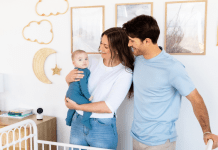American mother Debra Ollivier gave birth to her first child in Paris. When her baby reached the age of mobility, she shares, “I baby-proofed our apartment with rubber edge liners, covers on electrical sockets, latches on windows, locks on drawers and toilet seat guards… my French neighbor Genevieve took one look at our place and said: Your apartment looks like a psych ward.”

When did American homes begin to bear some semblance to psychiatric institutions? When did the five-point harness become the norm for high chairs? And when did we decide it would be better to blockade the buttons on the television than to teach our children what it means when parents say “no”?
We childproof out of fear. But we also childproof because it makes life easier. In previous generations, childproofing was used to keep children safe from life-threatening danger. This still holds true. Today, the childproofing industry has expanded to create products that prevent every possible bump and bruise.
As protective, caring mothers, we have a tendency to let fear drive our decision-making processes. The “better safe than sorry” principle holds strong in many homes. Personally, I don’t “live on the edge”, or even close to it. I am constantly in fear.
Before my son Nicolas was born I made myself a promise, I would not let my fears get in the way of him living his life.
I had many hopes and dreams for him, but above all, I wanted him to be curious about the world around him. I wanted him to be curious about what was in the kitchen cupboards. Curious about the contents of the liquids in the toilet. And maybe even curious about how it feels to bang his head on the corner of the coffee table.
At 10 months old he spent time pondering over the top of staircases, trying to figure out his next move. By the time he turned one, he had learned he had to sit and wait patiently for piping hot food to cool down—or he would burn his tongue. At 13 months of age, I transitioned him from a crib to a toddler bed. Without a safety rail. Then I stopped buckling him into the high chair. At 18 months, he is currently helping me flip pancakes on an electric griddle. And he has lived to talk about it.

I love my son. And I supervise him closely. I truly believe he is going to be a safer, more intellectually curious human being as a result of having experiences to test the boundaries and limits of his environment. I also believe that I will be a more confident, fearless mother by using these early opportunities to practice my hand at setting limits, teaching discipline, and modeling safety. Not to mention that his immune system will be stronger from sticking his hands in the toilet repeatedly.
Over-the-top-childproofing can deny children of the opportunity to make mistakes and learn to respond to structure. Babies and toddlers can be taught to be careful. They can make mistakes, but they can also learn from them. They can be taught not to touch everything in sight. All this is possible, but don’t get me wrong—it does take a great deal of time and attention.

So by all means, go ahead and plug the electrical outlets with plastic covers. And please anchor dressers and large furniture to the walls. Put toxic products and medications out of reach. Likewise, arrange your home to protect children from all other life-threatening hazards.
But when it comes to childproofing, try not to overdo it. Consider leaving your cupboards unlocked. Don’t be afraid to chase your baby out of the toilet. Let your little one experience what it feels like to bump his head on the corner of the coffee table. Allowing children to practice managing moderate dangers and boundaries inside the home may be the first step in helping them to make good decisions when they step on the outside.














I’m a little offended by this post. I child-proofed my house to protect my child, not because of my lazy parenting style. Unfortunately, I work full-time outside of my home, and can’t be with my child every moment to ‘patiently’ teach him what it feels like to bump his head on the coffee table. I don’t think I’m lazy at all. As a matter of fact, I would love to clone myself so I can get everything done I need to in a day. God bless you mothers who have it all together. I am not one of them.
I am sorry to hear that this post didn’t resonate with you Roxanne! I am sure you “have it together” more than you think you do, especially with such a busy schedule 🙂 I appreciate you reading and your feedback.
I actually LOVE this post. I did a lot of child-proofing at my house, but I feel like most of it was done because I knew I couldn’t be in all of the rooms at one time. It is actually helping more now than it did then…not from a safety perspective, but from a sanity perspective. My 3 year old likes to put on my make-up. To keep from having eye shadow and any other make-up all over the house, I locked it. HA! I don’t really think the word is “lazy”. I think its more along the lines of busy or sometimes distracted. I put a baby gate on the entryway to our kitchen for a time mainly because I didn’t want every toy in the kitchen…not because I didn’t want them to learn that the stove was hot. In fact, the girls like to stand on step-ladders/chairs now and “help” me cook. I think the key for all of us is that with technology the way it is now, I have consciously make and effort to stop looking at the phone/ipad anytime I hear a notification. I want to be present with my kids. Sure, we all need time when they entertain themselves. I agree with this post keeping all seriously hazardous stuff blocked/plugged/out of reach of the littles, but I didn’t want rubber guards on all of my tables and walls. We’ve got to learn sometimes.
On another note, I think the purpose of Dallas Moms Blog and any other city is to encourage other moms. Not everyone is going to manage their house the same way and that’s okay. No post is written (at least I think) in the effort to “judge” or make any mom feel like her way is incorrect. It is simply about showing the multiple sides of the coins.
Any mom (or other parent for that matter) is for the most part trying to do what’s best for their family. There is no “perfect” parenting method.
Stay strong moms!
I agree that there is no “blanket approach” that works for everyone. It sounds like you have a “wait and see” approach, you waited to decide what you needed to do–rather than just following the status quo and buying every device Buy-Buy-Baby has to offer 🙂
The extent of child proofing depends on your child and your home. If your child has a high pain threshold, you make more of an effort to keep her away from the stove. If your child quietly lets himself out of exterior doors, you need more latches. If you have a pool, you need a fence & latches that only adults can reach. If you have multiple children, you need more restrictions. Common sense helps you build a balance between teaching them & enabling them to hurt themselves!
I really enjoyed this post! We have locks on any cabinets with cleaning supplies, but that’s it so far. Granted, our daughter is at school during the day. We recently rented a vacation condo with stairs and the other couple we were with was very nervous that no one brought a baby gate (a valid concern – as no one wants an injury on vacation!). We made an effort to take the time to let our 18 month of climb up and down the stairs supervised. There was one tumble but she also learned some new mobility tricks and now she loves to walk from our driveway up and down the stairs of our front porch independently since we’ve been home! A free ranging baby can take a lot of time, but even setting times for open exploration seems to have many benefits.
Hi Denaye. Thanks for the response. I have to apologize for my over-reaction to your post. It was actually chalked full of some great suggestions. Last night, I only used the lap belt on my son in his high chair and it worked just fine (I never liked him being strapped down like a mental patient anyway). Again, sorry for my previous post. I guess I was a little envious I didn’t think of some of these things first. 🙂 Have a great weekend!
No worries at all Roxanne! My hope with writing the post was that it might make some parents think twice when making decisions childproofing–sometimes we underestimate what are kids are capable of, especially because they grow up so fast 🙂
I must say that I completely disagree with this approach. While I do believe that our job as parents is not to pave the way and make things easy for our children, but instead teach them to deal with obstacles and disappointments themselves, I do not believe that this includes physical safety. Of course children need to explore and learn, but why make it more difficult for them to do so by not making things as accessible as possible for them? Put some plastic bowls and pots in the bottom cabinets so they can dig them out and play as much as they want! I see no reason to leave things out that they shouldn’t touch just to teach them the word “no”. When my children were small, I wanted their home to be a safe and fun place for them to grow and explore. I cannot see the positive in a child “hitting their head on the corner of the coffee table”, and I certainly can’t see the positive in a child having to hear the word “no” all day long.
I love this post. I am a mom of 3 kids and my husband and I have never baby proofed our home. My parents didn’t childproof the when we were little. We were just taught the word “No”.